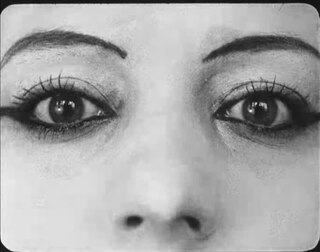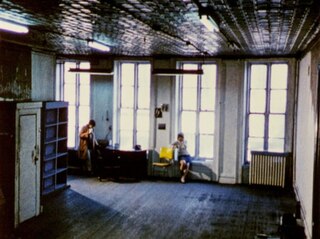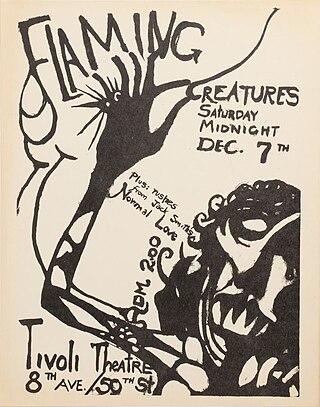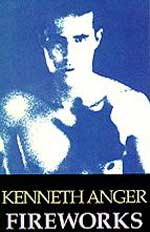
Experimental film or avant-garde cinema is a mode of filmmaking that rigorously re-evaluates cinematic conventions and explores non-narrative forms or alternatives to traditional narratives or methods of working. Many experimental films, particularly early ones, relate to arts in other disciplines: painting, dance, literature and poetry, or arise from research and development of new technical resources.
Structural film was an avant-garde experimental film movement prominent in the United States in the 1960s. A related movement developed in the United Kingdom in the 1970s.
Jordan Belson was an American artist and abstract cinematic filmmaker who created nonobjective, often spiritually oriented, abstract films spanning six decades.

Wavelength is a 1967 experimental film by Canadian artist Michael Snow. Considered a landmark of avant-garde cinema, it was filmed over one week in December 1966 and edited in 1967, and is an example of what film theorist P. Adams Sitney describes as "structural film", calling Snow "the dean of structural filmmakers."

Flaming Creatures is a 1963 American experimental film directed by Jack Smith. The film follows an ensemble of drag performers through several disconnected vignettes, including a lipstick commercial, an orgy, and an earthquake. It was shot on a rooftop on the Lower East Side on a very low budget of only $300, with a soundtrack from Smith's roommate Tony Conrad. It premiered April 29, 1963 at the Bleecker Street Cinema in Greenwich Village.
Peter Barrington Hutton was an American experimental filmmaker, known primarily for his silent cinematic portraits of cities and landscapes around the world. He also worked as a professional cinematographer, most notably for his former student Ken Burns, as well as cinematography for Lizzie Borden's Born in Flames, Sheila McLaughlin and Lynne Tillman's Committed, assorted films by artist Red Grooms and Albert Maysles' The Gates.

Fireworks is a 1947 homoerotic experimental short film by Kenneth Anger. Filmed in his parents' home in Beverly Hills, California, over a long weekend while they were away, the film stars Anger and explicitly explores themes of homosexuality and sadomasochism. It is the earliest of his works to survive. Fireworks is known for being the first gay narrative film in the United States.

Leonard Lipton was an American author, filmmaker, lyricist and inventor. At age 19, Lipton wrote the poem that became the basis for the lyrics to the song "Puff, the Magic Dragon". He wrote books on independent filmmaking and become a pioneer in the field of projected three-dimensional imagery. Leonard Lipton developed 3D cinema technology that is used in RealD 3D cinemas. His technology is used to show 3D films on more than 30,000 theater screens worldwide.

Nathaniel Dorsky is an American experimental filmmaker and film editor. His film career began during the New American Cinema movement of the 1960s, when he met his partner Jerome Hiler. He won an Emmy Award in 1967 for his work on the film Gaugin in Tahiti: Search for Paradise.
Cosmic Ray is a 1962 American experimental short film directed by Bruce Conner. With both found footage and original material, it features images of countdown leader, a nude woman dancing, a Mickey Mouse cartoon, and military exercises. It is soundtracked by a performance of Ray Charles's "What'd I Say" and has been recognized by some critics as one of the first music videos.
Robert Nelson was an American experimental film director.

Jerome Hiler is an American experimental filmmaker, painter, and stained glass artist. Having started in New York during the New American Cinema movement, Hiler and his partner Nathaniel Dorsky moved in 1971 to San Francisco, where for many years his work was shown in the context of private salon screenings. He began to publicly screen his films in the late 1990s, releasing new films regularly since 2010. Hiler's work makes use of vivid colors, musical rhythms or structures, and layered superimpositions edited in camera.
All My Life is a 1966 American experimental short film directed by Bruce Baillie. It shows a continuous shot of a fence, soundtracked by Ella Fitzgerald's 1936 debut single "All My Life". Film critic P. Adams Sitney identified it as an early example of what he termed structural film.
Anticipation of the Night is a 1958 American avant-garde film directed by Stan Brakhage. It was a breakthrough in the development of the lyrical style Brakhage used in his later films.
Side/Walk/Shuttle is a 1991 American avant-garde film directed by Ernie Gehr. It shows downtown San Francisco as seen at different angles from a moving elevator.
Adebar is a 1957 Austrian avant-garde short film directed by Peter Kubelka. It is the first entry in Kubelka's trilogy of metrical films, followed by Schwechater and Arnulf Rainer. Adebar is the first film to be edited entirely according to a mathematical rhythmic strategy.
The Way to Shadow Garden is a 1955 American experimental film directed by Stan Brakhage.
Blue Moses is a 1962 American experimental film directed by Stan Brakhage, starring Robert Benson.

Twice a Man is a 1963 American avant-garde film directed by Gregory Markopoulos.
The Illiac Passion is a 1968 American avant-garde film directed by Gregory Markopoulos.








